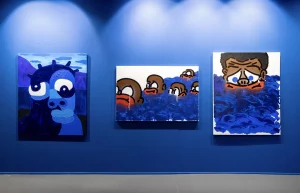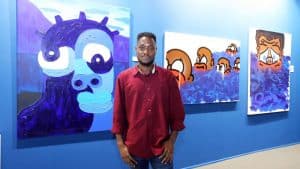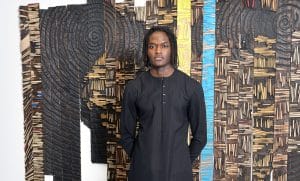
The Best Booths at Art Dubai, from a Verdant Office Space to Visions of Urban Decay
Isshaq Ismail (born c.1989 in Accra, Ghana) is a multidisciplinary artist and, a product of Ghanatta College of Arts and Design. He investigates and explores grotesque figures and textures in his paintings. Ismail’s works are a conversation on place and identity, providing an intimate look at social, cultural and political realities of living in this dynamic 21st century and poetically expressing how those realities ultimately impact one’s identity, and all about emotions and moods of the society. In 2015 and 2016 Ismail was shortlisted as one of the top ten artists in Ghana for the Kuenyehia Prize for Contemporary Art.
Join Isshaq Ismail in his Accra studio as he speaks about his artwork and how they provide an intimate look at social, cultural and political realities and their instrumentation in the shaping of identity.
Production: Project X Studios
Director: Alex Adu
D.O.P: Michael Ansah
Assistant Camera: Caleb Otchi
Production Assistant: Hector Kugbadzor
Editor: Michael Ansah
The Ghanaian painter’s grotesque figures transfix the viewer while they reflect on the universal human condition
They pierce the spectator with their huge eyes out of which they emit bold, direct and powerful stares. Their expressive grotesque forms painted in a variety of vibrant hues at once startle, console and captivate. They emanate a range of emotions at once—melancholy, anger, despair and joy. They are faces could belong to a man or a woman and to any ethnicity and race. At times they appear neutral, ungendered while at other times a more feminine or masculine character takes over. Based on the men and women that Ismail encounters each day in Accra, the artist aims for his figures and grotesque faces to transcend race, class and gender lines and be universal in representation and reach.
While their true persona is never revealed by the artist, Accra-based painter Isshaq Ismail (b. 1989), it is the energy and emotion that these portraits emanate that easily touch, move, and ignite a range of feelings in the viewer.
Ismail, who studied like many of his contemporaries at the acclaimed Ghanatta College of Art and Design from 2009-2012, has exhibited in both Ghana and internationally, including in New York, Miami, London, Cape Town, and Dubai. In 2015 and 2016, he was shortlisted for the Kuenyehia Prize for Contemporary Art; in 2016, he was one of the Top 100 finalists at the Barclays sponsored L’Artelier Art Competition in Johannesburg, and in 2019, he was shortlisted for the GUBA USA Influential Artist Award.
Ismail explains how the pedagogy that he and his other contemporaries studied at Ghanatta was 80 percent art practice and 20 percent theory. “We constantly needed to practice our art so that we could hone our draftsmanship,” he says. “After school I realized I had to unlearn and re-learn, and I had to look at my work within the context of history.” The work of Jean-Michael Basquiat and Francis Bacon particularly inspired him. However, he says he didn’t take them seriously when he was in school.
After Ismail graduated in 2012, he began to gentrify his practice. “My interests changed, and I became fascinated by grotesque images and surfaces,” he says. “I wanted to narrow the subject matter of my work down and push it and my creativity further. This is what led me to explore the grotesque figures that I am working on now.”
When Ismail started exploring grotesque images, he says how paramount themes to his practice were conversations revolving around place and identity. “I was interested in how the social culture and political realities of the 21st century influence us as humans. I wanted to use my faces to advocate for the voiceless.”
Through the artist’s poignant visages that prompt the spectator to transfix upon their grotesque forms and features, Ismail aims to portray the complex variety of emotions that people experience from everyday life. The artist perceived how many people consistently struggle with their emotions and with trials and turbulations of living. “Many feel they they cannot voice their concerns or speak about what they are going through,” he says, noting how he was influenced by the people he would encounter on his rides on public transport in Accra, the individuals in the marketplace or who are driving for Uber, as well as the calamities pertaining to the news cycle. “Such moments influence my work in the studio which then leads me to capture them in a spontaneous manner on canvas.”
There’s a child-like wonder to the artist’s grotesque faces and figures. While they are brutalist in form, they are also endearing to behold. Ismail produces many sketches, sometimes from his imagination while other times from photographs before he renders each portrait or figure. “I adapted my technique to a semi-infantile form of abstraction,” explained Ismail. “The work has a charm-like fever to it now. Life is not perfect, so I don’t see why I need to create perfect forms.” He also likes to work in series so that multiple bodies of work can be in dialogue with each other. Rather than attach titles to his works, Ismail numbers them and then puts words in his mother Ghanaian tongue of Twi. For example, “Onipa Anim 1” means “human face 1” in Twi. “I want to use our own local names for the portraits,” he says. In so doing, he brings the work back to Ghana and his own heritage and language.
Through his paintings Ismail also aims to offer “honest portrayals” of the people he captures. “Anxiety, anguish and empathy—I want to capture emotions you find in society,” he says. Yet Ismail’s characters are also ambiguous, and he wants them to be seen as such. They don’t have a clear identity, gender, class, or race. “They are anonymous so that they can have a global language,” says the artist. “When you look at these characters you question where they are from. I am capturing within these figures, aspects of Ghana and aspects of the global community.”
Ismail’s grotesque portraits don’t just penetrate the viewer’s gaze, the emotional impulse the viewer feels is also from their explosion of color. The expressions so subdued, melancholic, that the joyful vibrancy of the artist’s electric hues is almost unexpected. “I have no hierarchy when it comes to my color palette; I just want them to be interesting,” he says. At times, he adds, he aims for color blocking as one would find in fashion so that one color is dominant rather than several at once. “Every day engage in fashion and popular culture, and I borrow color from here too,” he says. “Through color my figures take on different identities inhabiting different spaces.”
There’s the blue face, the black face, the red face, the green face, and the yellow face. In so doing, Ismail pushes the boundaries not just of color but of identity and race. Use of a multitude of colors serves to obfuscate ideas of race to focus instead on the individual rather than their color. “I don’t just want to make black faces; if I want to use red, I should be able to use red so that I can endow my characters with various emotions that so many people are going through now and always and this is important to me,” he underlines.
Through color, form and emotional complexities Ismail’s portraits break all boundaries. They aren’t just African or occidental. They are merely human beings, experiencing, surviving, and wrestling with the same emotions, pain, happiness, sadness, and despair that are experienced all over the world. Through their grotesqueness and their penetrating gaze, the artist emancipates his figures from the stereotypes of identity making a visual statement that we have more in common than what sets us apart.
Read more...

The Best Booths at Art Dubai, from a Verdant Office Space to Visions of Urban Decay

Art Dubai returns with glaciers, feminism and precious stones inspiring creatives

Dubai Gallery presents Ghanaian contemporary art at Christie’s London

As Christie’s in London collaborates with Efie Gallery to present an exhibition of West African art entitled Material Earth, we talk to the gallery’s co-founder, Kwame Mintah, about why Ghanaian artists in particular are attracting so much attention worldwide

Christie’s are collaborating with Efie Gallery, Dubai, to present an exhibition of three
pioneering Ghanaian artists, El Anatsui, Yaw Owusu, and Isshaq Ismail

For its debut exhibition, Efie Gallery has pulled out all the stops. As part of its foray into the UAE art scene, the new arrival has brought in three new pieces and ongoing work by renowned artist El Anatsui